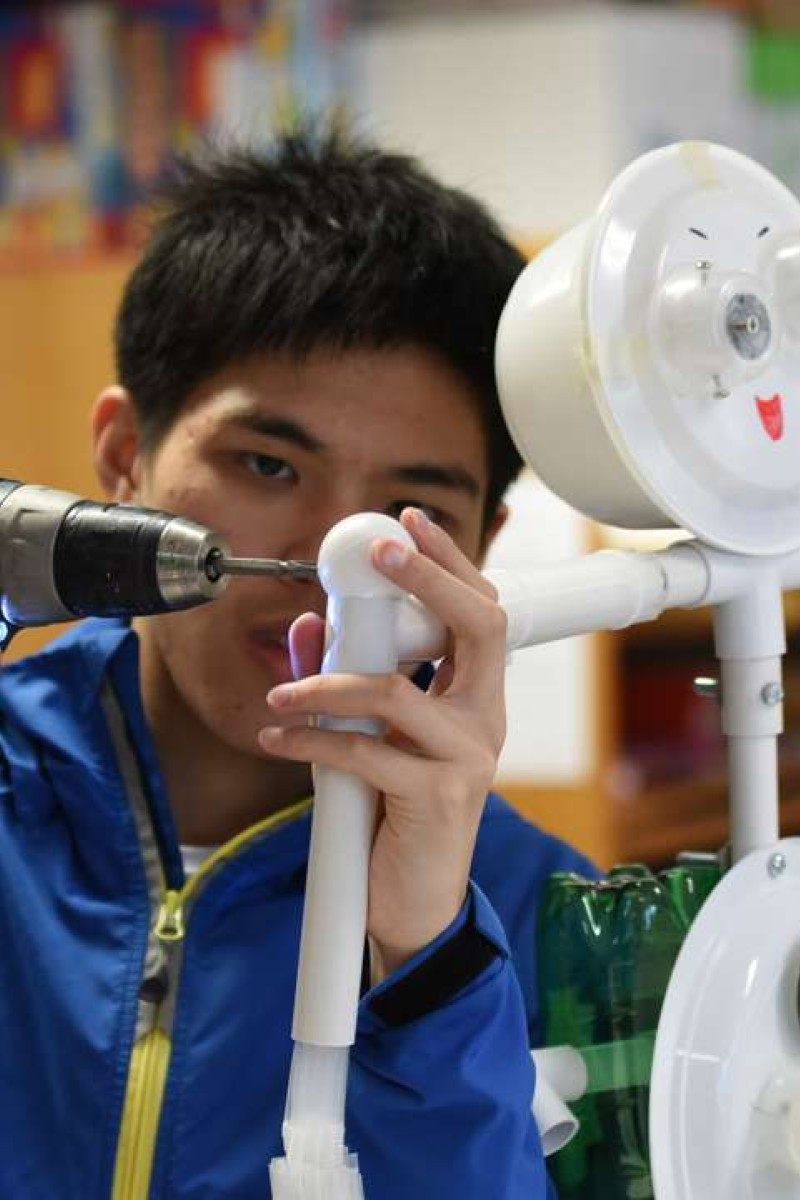 Chan Ka-Lun makes his own robot.
Chan Ka-Lun makes his own robot. Building a robot isn’t easy, and it’s not any easier when you have special needs. But there are no rules when it comes to the potential of human beings, as students from C.C.C. Kei Shun Special School recently found out. The school caters for students with special needs. Eight of its students took part in “Just-tifying Touch: Flying with Art Inclusion Programme” last month, organised by the Hong Kong Society for Education in Art, to create movable robots.
To find out more about the ideas behind the robots, Young Post talked to three of the participants, Lee Lok-lun, Chan Ka-lun and Tong Tsz-ching.
“I used to draw animations with an NDS [a handheld game console],” says 16-year-old Lok-lun, who has high-functioning autism. But Lok-lun isn’t going to let this stop him from doing things that everyone else does. In fact, he does some things even better than most people – like graphic design. “I’m addicted to graphic design. But I don’t have any expensive software so I’m using a free programme called Inkscape. It’s pretty good,” he says.
While Lok-lun is an experienced designer, some of the DIY steps involved in the robot-making process were a bit of a challenge. “It was very difficult to stabilise the robot using masking tape, and I wasn’t sure where to put the screws,” he says.
Lok-lun’s friend, Ka-lun, 18, is very much into graphic design as well. “I like portraying real objects, but on computers,” he says. But he chose to challenge himself. Ka-lun modelled the robot on himself. “My robot, Deity Robot 2015: Autumn, is supposed to represent a strong character. I used straws to form the muscles, then inserted two plastic bottles at the back to make a small rocket. I covered its eyes with small plastic cups and put two LED lights inside to create a pair of sparkling eyes. But that’s not all – the hands of the robots also rotate,” he says.
While he enjoyed it, Ka-lun says he won’t be making it a regular habit.
“A robot isn’t something I would make every day as it is not very easy to complete by yourself. Like Lok-lun, I prefer graphic design,” Ka-lun says.
Tsz-ching wasn’t the only girl from the special school participating in the project but her colourful and complicated robot was really eye- catching. “My robot, called Bloody Weapon, shows blood vessels and muscles in the human body. I used electrical wires in different colours to represent all the different parts,” says the 15-year-old. “And I put LED light bulbs in its eye sockets so that it lights up. I think it’s cute.”
Although the trio are very artistic, they paired up with artist Yung Chi-kin to gain some professional help in the robot-making process.
“The thing that I like the most is that every robot reflects the personality of the maker. Looking at the finished robots, I feel as though I am looking at the creators behind them,” says Chi-kin.
Through the robots, Chi-kin can see the different characters of the students. “Some students focus on expressing their emotions, while some are into the precision of the art. Others are eager to express their world view through their creation or let their imagination go wild. And some just like to have fun with the tools.”
Having been involved in engineering and creative fields for years, Chi-kin says that robot-making is not easy. “Aesthetics aside, the creators have to deal with both technical and structural challenges. But these students weren’t threatened by those aspects at all, and kept going until they had each built their own robot.”
